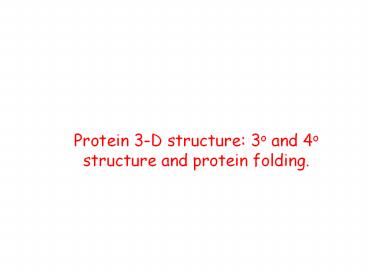Protein%203-D%20structure:%203o%20and%204o%20structure%20and%20protein%20folding. - PowerPoint PPT Presentation
Title:
Protein%203-D%20structure:%203o%20and%204o%20structure%20and%20protein%20folding.
Description:
Proteins with similar 1o structure also have similar 3o structure ... Helix-loop-helix all alpha-helix. Coiled-coil. Helix bundle. Beta meander all beta sheet ... – PowerPoint PPT presentation
Number of Views:189
Avg rating:3.0/5.0
Title: Protein%203-D%20structure:%203o%20and%204o%20structure%20and%20protein%20folding.
1
- Protein 3-D structure 3o and 4o structure and
protein folding.
2
3o Structure
- third level of protein organization
- folding of polypeptide chain causes 2o structures
to interact - formation of motifs and domains
3
Proteins with similar 1o structure also have
similar 3o structure
tuna 1 GDVAKGKKTFVQKCAQCHTVENGGKHKVGPNLWGLFGRK
TGQAEGYSYTDANKSKGIVWNyeast 1
GSAKKGATLFKTRCLQCHTVEKGGPHKVGPNLHGIFGRHSGQAEGYSYTD
ANIKKNVWDErice 1 GNPKAGEKIFKTKCAQCHTVDKGAGHKQ
GPNLNGLFGRQSGTTPGYSYSTANKMAVIWEEtuna 61
ETLMEYLENPKKYIPGTKMIFAGIKKKGERQDLVAYLKSATSyeast
61 NNMSEYLTNPKKYIPGTKMAFGGLKKEKDRNDLITYLKKACEric
e 61 NTLYDYLLNPKKYIPGTKMVFPGLKKPQERADLISYLKEATS
4
Common Motifs
- Motif Composition
- Helix-loop-helix all alpha-helix
- Coiled-coil
- Helix bundle
- Beta meander all beta sheet
- Greek key
- Beta-alpha-beta mixed alpha/beta
5
Motifs Combine to form Domains
- Domains are independent folding units in a 3o
structure of a protein - Individual domains have specific function
Parallel twisted sheet
- Hydrophobic interactions are the major driving
force in folding domains
Alpha/beta barrel
6
Protein family members share common domain
structures
lactate dehydrogenase
malate dehydrogenase
NAD
NADH
7
4o Structure
- Quaternary structure describes the organization
of subunits in a protein with multiple subunits
(oligomeric protein) - Can have homo-multimers or hetero-multimers
a2b2
a2bg
8
4o Structure
- Determine molecular weight of native protein by
gel permeation chromatography - Determine molecular weight of individual subunits
by SDS-PAGE - Can use the information to determine subunit
composition
If. Native protein 160,000 daltons and
a-Subunit 50,000 daltons b-Subunit 30,000
daltons Then Protein can have a2b2 structure
9
4o Structure
- Subunits held together by non-covalent
interactions - Oligomeric protein is more stable than
disassociated subunits - Active site often made up of AA residues from
different subunits - 4o and 3o structure is often affected by ligand
(substrate or inhibitor) binding. Important in
enzyme regulation
10
Protein denaturation
- Denaturation disruption of native conformation
- Heat commonly used to denature proteins
- Tm temperature where 50 folded/50 unfolded.
- Typical Tm 40-60oC
- Tm for thermophiles gt100oC (Taq DNA
polymerase) - Chemical denaturants Chaotrophic agents Urea,
KCN detergents SDS
11
Protein Folding
- Ribonuclease A (RNase A) will refold to native
structure spontaneously (1 minute) - gt1050 possible conformations
- If 10-13 sec per conformation would take 1030
years to sample enough to determine structure - How do proteins fold so quickly?
12
Factors driving protein folding
- Conformational entropy AB ? C decreases entropy
(unfavorable) - Non-covalent interactions give favorable enthalpy
value - Hydrophobic effect increases entropy by freeing
water (favorable)
DG DH - TDS
-
13
Protein Folding
- Structures of globular proteins are not static
- Proteins breathing between different
conformations - Proteins fold towards lowest energy conformation
- Multiple paths to lowest energy form
- All folding paths funnel towards lowest energy
form - Local low energy minimum can slow progress
towards lowest energy form
14
Pathway of Protein Folding
1) Nucleation of folding - Rapid and reversible
formation of local 2o structures form
2) Formation of domains (Molten Globular
intermediates) through aggregation of local 2o
structures
3) Domain conformations adjust to form native
protein
15
Chaperonins
- Protein complexes that promote protein folding
- Chaperonins dont determine native structure
- Prevent misfolding and aggregation of protein
- Sequesters unfolded protein from other proteins
- Require ATP for protein binding, after ATP
hydrolysis native protein released - Thought to bind unfolded regions of protein
16
Disulfides Bonds
- Stabilize native structure
- Formed after native conformation achieved
- Abundant in secreted proteins but not in
intracellular proteins - Protein disulfide isomerase catalyzes reduction
of incorrect disulfide linkages































